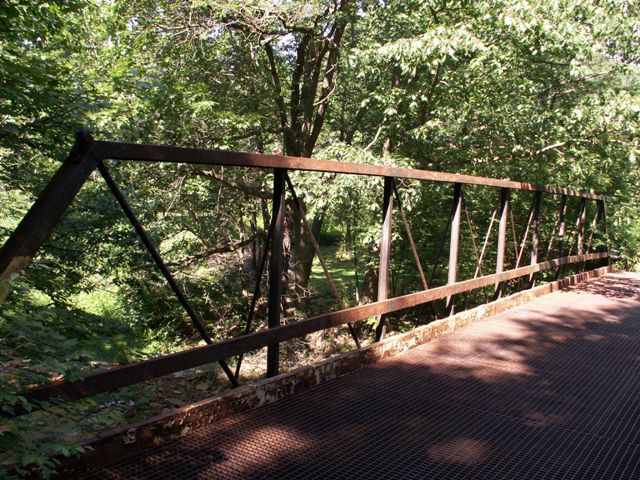We Recommend:
Bach Steel - Experts at historic truss bridge restoration.
BridgeHunter.com Phase 1 is released to the public! - Visit Now
Bridgeport Road Bridge

Primary Photographer(s): Nathan Holth and Rick McOmber
Bridge Documented: July 14, 2008
Rural: Clearfield County, Pennsylvania: United States
By Builder/Contractor: Columbia Bridge Works of Dayton, Ohio
1930
71.0 Feet (21.6 Meters)
74.2 Feet (22.6 Meters)
15 Feet (4.57 Meters)
1 Main Span(s)
17722602060005

View Information About HSR Ratings
Bridge Documentation
View Archived National Bridge Inventory Report - Has Additional Details and Evaluation
This bridge is a bridge that is very significant because of two main factors. First, it is among a relatively small group of significant bridges in the country that contain cast iron components. While not a true cast iron bridge since all main members are wrought iron, several components on this bridge are cast iron. The second factor of significance is that this bridge is a rare example of the work of an important and creative bridge company, the Columbia Bridge Works, and this bridge displays the distinctive details of that company. The Columbia Bridge Works was noted for its bridges dating to the 1870s and 1880s that utilized a large number of rolled beams in its members rather than built-up beams that were more common in the period due to the limited size (and potentially a higher cost) of rolled beams caused by the limited technology and facilities of the iron/steel mills of the period. However, the use of rolled beams by the Columbia Bridge Works in the 1880s foretold of a trend that would spread throughout the bridge world, but amazingly not until decades later. In this sense, Columbia Bridge Works was ahead of its time.
The Bridgeport Road Bridge today is abandoned in a heavily shaded setting, and is an excellent representative example of a Columbia Bridge Works pony truss. It includes a rolled top chord and end post beam, as well as rolled beam vertical members. Connection bracket assemblies are made of cast iron.
Information and Findings From Pennsylvania's Historic Bridge InventoryDiscussion of Bridge The one-span, 74'-long, wrought- and cast-iron Pratt thru truss bridge built ca. 1885 is supported on stone abutments. The bridge exhibits uncommon surviving period details including the cast-iron connecting pieces, flat bar lower chords with bolted lap joints, and verticals composed of I beams. The bridge members are joined by a combination of pin connections and compression fittings. The details are distinctive of the work of the Columbia Bridge Works of Dayton, OH. The bridge is a rare and exceptionally complete example of a cast- and wrought-iron truss bridge. Its construction is representative of the historically significant era of experimentation in metal truss bridge construction following the Civil War when bridge builders developed a diversity of iron truss bridge designs and details. The bridge is historically and technologically distinguished. Discussion of Surrounding Area The bridge carries a 2 lane road over a stream in a rural wooded area southeast of Bridgeport. The east approach road curves sharply to meet the bridge. The setting does not have historic district potential. Bridge Considered Historic By Survey: Yes |
![]()
Photo Galleries and Videos: Bridgeport Road Bridge
Bridge Photo-Documentation
Original / Full Size PhotosA collection of overview and detail photos. This gallery offers photos in the highest available resolution and file size in a touch-friendly popup viewer.
Alternatively, Browse Without Using Viewer
![]()
Bridge Photo-Documentation
Mobile Optimized PhotosA collection of overview and detail photos. This gallery features data-friendly, fast-loading photos in a touch-friendly popup viewer.
Alternatively, Browse Without Using Viewer
![]()
Maps and Links: Bridgeport Road Bridge
Coordinates (Latitude, Longitude):
Search For Additional Bridge Listings:
Bridgehunter.com: View listed bridges within 0.5 miles (0.8 kilometers) of this bridge.
Bridgehunter.com: View listed bridges within 10 miles (16 kilometers) of this bridge.
Additional Maps:
Google Streetview (If Available)
GeoHack (Additional Links and Coordinates)
Apple Maps (Via DuckDuckGo Search)
Apple Maps (Apple devices only)
Android: Open Location In Your Map or GPS App
Flickr Gallery (Find Nearby Photos)
Wikimedia Commons (Find Nearby Photos)
Directions Via Sygic For Android
Directions Via Sygic For iOS and Android Dolphin Browser
USGS National Map (United States Only)
Historical USGS Topo Maps (United States Only)
Historic Aerials (United States Only)
CalTopo Maps (United States Only)

